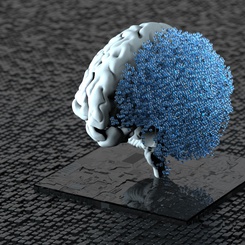The dramatic progress of artificial intelligence (AI) is affecting many sectors and functions of business. In his research paper “Augmented analytics”, to appear in 2019 in the journal Business & Information Systems Engineering, Professor Nicolas Prat focuses on the impact of AI on analytics. How is AI revolutionizing analytics, and what are the opportunities and challenges for managers?
“Analytics” refers to the technologies and processes for collecting, blending, modeling, analyzing and visualizing data in order to gain insights and make better decisions. Different types of analytics have been defined: descriptive, diagnostic (inquisitive), predictive, and prescriptive.
The term “analytics” became popular in the mid-2000s. In the early 2010s, the big data revolution gave rise to big data analytics. Self-service business intelligence (BI) empowered business users to analyze their data and generate their own visualizations without systematically resorting to the IT department. Today, AI (more specifically, machine learning and natural language processing) is bringing about a new revolution in analytics. Gartner calls this revolution “augmented analytics”. Others talk about “the cognitive generation of decision support”, “smart analytics” or, more simply, “AI-powered analytics”. Predictive analytics (and, more generally, advanced analytics) has traditionally relied on machine-learning algorithms, like neural networks, for the development of models. However, what is new with AI-powered analytics is the scope of applications of AI throughout the analytics cycle. This includes, for example, the application of machine learning to find the best machine-learning model (applying machine learning to the automation of machine learning…).
Artificial Intelligence Is Permeating the Whole Analytics Cycle
The typical analytics cycle is composed of the following phases:
- Phase 1: identification of the business problem addressed by analytics, as well as the opportunities of big data analytics for the business.
- Phase 2: data preparation (“wrangling”), decomposed into data profiling (assessment of data quality) and transformation.
- Phase 3: data analysis. In this phase, a distinction is made between data discovery (that may be performed by analysts or decision makers using self-service BI tools) and modeling (model building and evaluation by data scientists).
- Phase 4: deployment of the models in production systems.
- Phase 5: decision based on the insights from the data.
- Phase 6: action implementing the decision.
- Phase 7: monitoring of the results of actions, e.g. to improve the models.
The examples below give a sample of applications of AI to the analytics cycle. Although these applications differ in maturity, they are already realities. Many more are likely to emerge as AI continues to approach human intelligence.
In phase 2, some tools guide users in data preparation, e.g. by suggesting data transformations to clean or standardize the data. AI-enabled automation here may significantly improve efficiency, as data preparation often takes more than two-thirds of the time in the analytics process.
In phase 3, machine learning and natural language processing are significantly transforming data discovery. Examples include the enhancement of visualizations with advanced analytics (clustering, forecasting), guidance in data discovery (suggestions of relevant visualizations based on the current stage of data discovery), natural language data querying, and natural language generation (automatic generation of the text summarizing the insights from a visualization). In modeling, some tools use machine learning to automate the generation and assessment of machine-learning models, traditionally a major role of data scientists.
In phases 5 and 6, some operational decisions are already made and implemented automatically thanks to AI. High-frequency trading is a case in point.
Democratization of Analytics
Decision support systems (DSS) appeared in the 1970s. They have evolved to give business users more and more freedom in analyzing their data to gain insights and make relevant and timely decisions. Executive Information Systems (EIS) were the early version of electronic dashboards, aimed at top managers. Thanks to the development of data warehouses, business users were able to generate reports independently, i.e. without systematically resorting to the IT department. With self-service BI, the democratization of analytics was pushed a step further, with tools like Tableau, Qlik, or Power BI, facilitating data discovery and visualization. However, these tools were still limited to traditional BI tasks: reporting, OnLine Analytical Processing (OLAP), and dashboards. “Smart data discovery” (a term coined by Gartner) enhanced self-service BI tools with advanced analytics. For example, IBM Watson Analytics heavily relies on predictive analytics. Smart data discovery lowered the barrier to entry to advanced analytics for domain specialists, business users, and managers, virtually making them into what Gartner calls “citizen data scientists”. With the last generation of AI-powered analytics, the democratization of analytics extends beyond data discovery. Thus, at least in principle, you do not need to be an IT professional to clean data or a data scientist to generate and evaluate machine-learning models.
The claim that data-driven decision making leads to better decisions and that mastering analytics leads to better performance is now commonly accepted and supported by empirical evidence. In the age of big data and the Internet of Things, data relevant for decision making are more and more abundant, more and more diverse, and decisions should be made more and more quickly. This context, coupled with a lack of data scientists, requires business users to play an increasing role in the analytics process. AI-powered analytics makes it possible. However, the rise of AI-powered analytics raises several challenges. Governance of analytics and, in particular, ensuring data quality, is a major challenge.
Data Quality and Governance
The quality of analytics is heavily dependent on the quality of input data (“garbage in, garbage out”). In practice, data are often incomplete, inaccurate, inconsistent, or biased. The fact that AI-powered analytics democratizes data preparation multiplies the risks of bad data. Moreover, data quality influences trust in AI-powered analytics, as it influences trust in AI more generally. Humans still have a major role in ensuring data quality, e.g. in the interpretation of “bad data”.
Beyond data quality, AI-powered analytics makes the governance of the whole analytics cycle more crucial and challenging. This cycle is complex, may be composed of several sub-cycles, and may be instantiated in many different ways. It involves many stakeholders and tools. The democratized access to analytics, redefining the roles of stakeholders, further complicates the orchestration of the analytics cycle.
With the digital revolution, some tasks traditionally assigned to the IT department have moved to other functions. However, this department has a crucial role to play in the governance of IT in general, and analytics in particular, e.g. through the definition of processes, roles, and common standards, in dialogue with managers.
Where Artificial Intelligence (Still) Cannot Beat Humans
By enabling the automation of tasks traditionally accomplished by human agents, the advent of AI-powered analytics brings about a redefinition of roles. The traditional roles in the analytics cycle should evolve by considering the skills that still give humans a competitive advantage over machines. Even if the accelerating speed of technological progress is gradually pushing the limits of AI, humans typically outperform machines in the following skills: question asking (finding problems as opposed to solving them), creativity, interpersonal skills, and social intelligence. These skills suggest ways of evolving the roles of data scientists, analysts or business users in the analytics process. Data scientists, threatened by AI in their very function of model creation and evaluation, could strengthen their role in the early phase of the analytics cycle: identifying the business questions that the machine-learning models will help answering. Data scientists, as well as analysts, should sharpen their storytelling skills. Like the art of writing novels, storytelling with data requires creativity. Finally, business users could exploit their social skills to make analytics a more collective process. Contrary to the group decision support systems (GDSS) of yesteryears, the main analytics systems of today very much focus on individuals. Using virtual or augmented reality (immersive analytics), business users may analyze data collectively and discuss insights before making a common decision.
If properly managed, AI-powered analytics provides an opportunity to analyze more data, more efficiently, and, ultimately, to make better decisions. Beyond the challenges mentioned above, many questions require further investigation by researchers and practitioners, such as:
- Should all business users take the role of “citizen data scientist”, or should a specific category of business users play this role?
- To what extent does AI improve the perceived usefulness and perceived ease of use of analytics systems?
- What are the key determinants of success of AI-powered analytics?
- What are the main factors affecting the credibility of the insights that AI-powered analytics generates and trust in the decisions that it suggests or makes?









